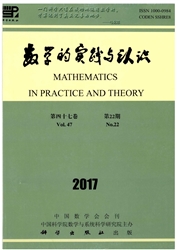

 中文摘要:
中文摘要:
利用局部灵敏度分析方法和Morris全局灵敏度分析方法,分析了二维瞬时投源河流水质模型方程解析解输入参数的误差对计算结果的影响程度,分别对模型方程输入参数的灵敏度进行计算并比较,讨论了单参数及多个参数相互作用下的系统扰动对污染物浓度计算结果的影响;绘制了局部灵敏度分析法下各参数的灵敏度变化曲线。灵敏度分析结果显示:二维河流水质模型方程解析解对不同参数的敏感程度不同,其中河流的平均流速最为灵敏,而污水排放点的位置坐标的灵敏性最弱;各参数间存在着相互作用,各参数灵敏度大小顺序为|S_u|〉|S_(Dy)|〉|S_(y0)|〉|S_(x0)|,但定量地分析各参数的灵敏度值却是不同的,Morris全局灵敏度分析方法综合考虑了多个参数间的相互作用,故其结果较局部灵敏度法更为可靠,更能反映实际情况。
 英文摘要:
英文摘要:
The influences of input parameter errors on the calculation result of 2-D river water quality model were analyzed using local sensitivity analysis and Morris global sensitivity analysis respectively. The sensitivity of analytical solution to input parameters were calculated and compared; the influence of system disturbance on calculated results of pollutant concentration under the action of single parameter or multiple parameters was analyzed. Furthermore,curves of sensitivity obtained from local sensitivity analysis method were given. The results reveal that the sensitivities to parameters were different: the average flow velocity of river is the most influential,whereas the location of pollutant discharge has the weakest influence on pollutant concentration. The sensitivity of calculation result to parameters follows the order of | S_u| 〉|S_(Dy)|〉 |S_(y0)|〉| S_(x0)|. Besides,the sensitivity calculated by local analysis under the changes of single parameter is different from that by Morris global analysis. Morris global analysis considers the interaction among multiple parameters,therefore is more reliable than local analysis and better reflects the real situation.
 同期刊论文项目
同期刊论文项目
 同项目期刊论文
同项目期刊论文
 Nonlinear Analysis of a New Extended Lattice Model With Consideration of Multi-Anticipation and Driv
Nonlinear Analysis of a New Extended Lattice Model With Consideration of Multi-Anticipation and Driv 期刊信息
期刊信息
